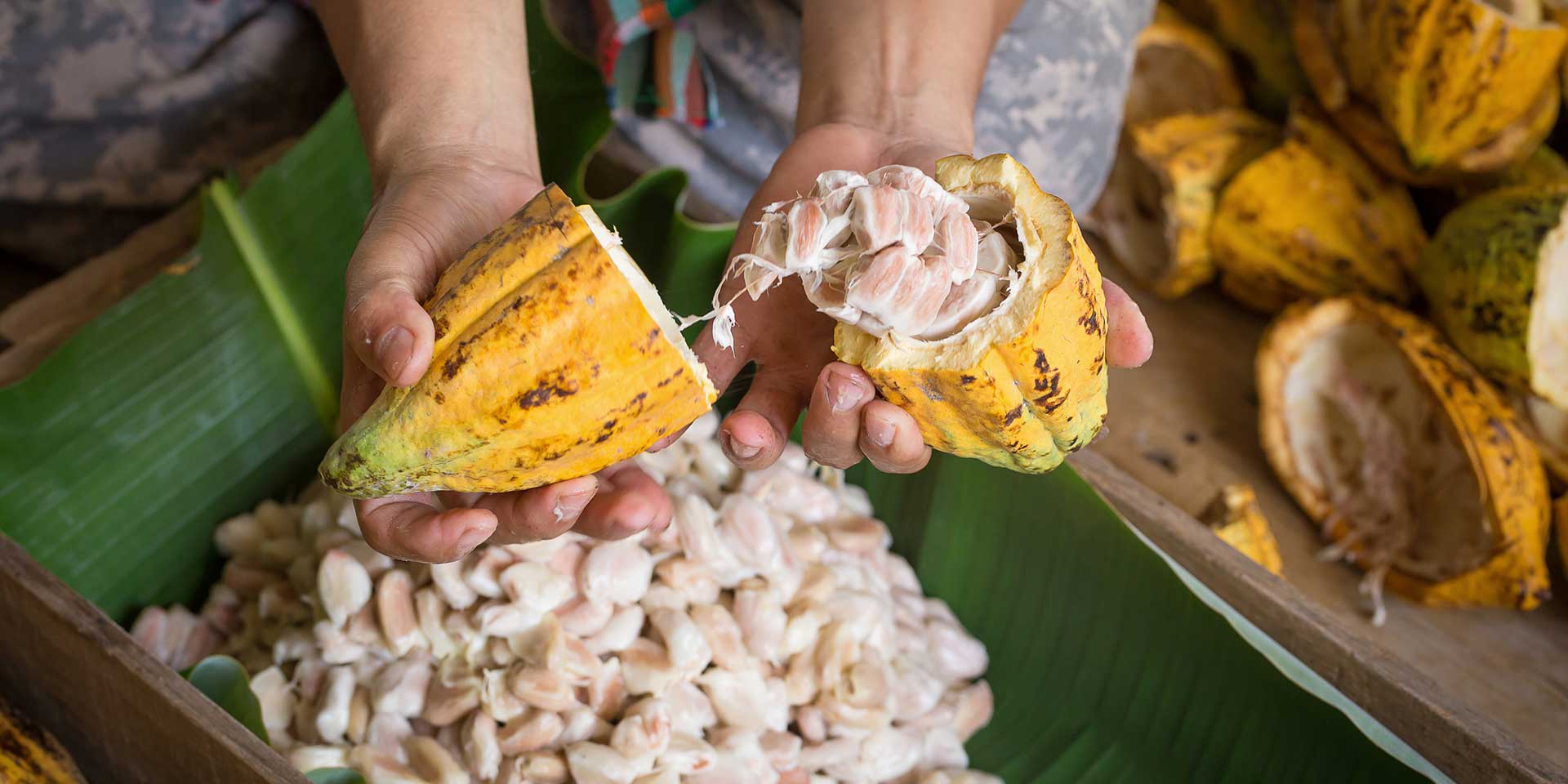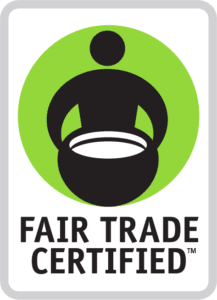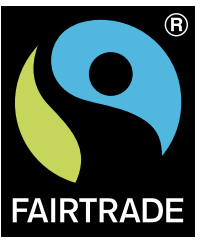The Basics of Fair Trade Labels
You might not know it from its generally low price tag, but chocolate has a host of production issues, from child labor on cacao farms to issues with deforestation. Chocolate isn’t alone in this either: many of our everyday foods, like coffee, bananas and more, are tropical products with invisible supply chains. A number of labels, especially those that invoke “fair trade,” market themselves as a more ethical option, but they usually come at a price premium. So how can you tell if paying extra is worth it? How do fair trade products differ from their conventional counterparts? And does paying more for these products actually guarantee anything meaningful for the people who produced them?
What is the Fair Trade Movement?
At its core, fair trade is meant to empower producers in the Global South —economically disadvantaged countries where colonialism and ongoing economic exploitation have contributed to low incomes and standards of living, mostly in the southern hemisphere — by giving them a more equitable place to trade goods than they can normally access on the global market. While fair trade can cover any number of items, fair trade in the food system tends to focus on tropical products like cocoa, coffee and bananas, which most people in the U.S. expect to be readily available. But in order to keep these beloved products cheap, most companies have developed opaque supply chains that have serious problems with child labor, deforestation and more, trapping farmers and workers in poor conditions that local governments, which have little incentive or ability to fight powerful corporations, don’t protect them from.
The fair trade movement’s philosophy asserts that if inequitable trade practices create these dynamics, better trade systems can reverse them and become an engine for equity and development. So what does that look like in practice? This varies based on what organization you talk to, but fair trade arrangements usually group producers or workers together into cooperatives, where they can ensure they meet certain production standards. This allows them to connect with businesses and traders with more leverage than they would otherwise have. Businesses and brands that buy from fair trade producers agree to pay a higher price for goods than would otherwise be offered, with that money returning to the producers and stabilizing incomes.
Worldwide, the fair trade movement has organizations operating at several different scales. Many of the early players in fair trade were individual companies or cooperatives, but several larger organizations have influence worldwide today. Fairtrade International is the largest of these organizations, with business networks bringing products that they certify as “Fairtrade” to markets in Europe, India, Asia, the Americas and the Pacific. The World Fair Trade Organization has a similar reach, but operates on a slightly different model, certifying businesses and organizations rather than individual products — although their label does end up on products from organizations that qualify. And then there’s the Fair Trade Federation, which is an association of businesses in the U.S. and Canada that adhere to fair trade principles. But while businesses and brands that are a part of the Fair Trade Federation are expected to source their agricultural goods from “economically and socially marginalized producers in a manner consistent with Fair Trade Federation principles” there’s not a requirement for external auditing, and an actual fair trade certification from another agency isn’t required for membership in the Federation. Ultimately, some of the companies in the Federation do have certification from one of the other organizations, but not all of them do. The Federation itself doesn’t offer a certification or label, but companies may market their products based on their membership in the Federation.
Fair Trade Organizations in the U.S.
Of the various fair trade organizations, two are prevalent in the U.S.: Fairtrade America, a branch of Fairtrade International, and Fair Trade USA. If the names of the organizations weren’t already confusingly similar, the certifications they offer — the Fairtrade Mark and Fair Trade Certified, respectively — even have similar logos, stylized human figures over green and black circles.
But there are some critical differences between the organizations that impact how they do business today, and, by extension, who they’re willing to certify. Fair Trade USA originated in 1998 as TransFair USA, certifying coffee, then eventually adding tea, cocoa and a few other products. It worked closely with other fair trade organizations, and was a part of Fairtrade International until 2011, when it announced it would be splitting with the international system over different approaches towards growing the fair trade sector.
Per Fair Trade USA’s logic, growing the umbrella of fair trade products was ultimately more important than stringently enforcing standards, leading them to step away from strict worker coops and partner with companies like Walmart, Dole and Kroger, large multinationals whose reputations for low-cost products and opaque supply chains don’t make them natural partners for a fair trade certifier. Fair Trade USA’s decision to certify coffee some plantations (which most alternative trade organizations viewed as fundamentally incompatible with worker-owner ideals) if they met labor standards was particularly controversial, attracting derision from other organizations like the Institute for Agriculture and Trade Policy and companies which previously held certification from Fair Trade USA like Equal Exchange and Dean’s Beans.
Critics held that Fair Trade USA’s approach to governance didn’t center farmers, and while it still represented a more socially responsible approach than conventional trade, it was no longer fair trade in its proper form.
But the split ultimately belied a deeper issue common to all the large fair trade organizations. As Rudi Dalvai, Former president of the WFTO opined at the time of the split, by focusing on certifications that provide guilt-free products to consumers, the fair trade movement’s focus had effectively moved towards supplying consumer demand over empowering producers. And brands that carried a limited number of fair trade products or sourced even a few fair trade ingredients could exploit labels by claiming to be invested in fair trade, even when the majority of their products still utilized conventional supply chains, leading to a situation where “a development tool becomes a marketing tool.”
Clearly, shopping at a grocery store for products with a fair trade label isn’t a complete divestment from the exploitative global economy that made fair trade a necessity in the first place; the current, certification-focused fair trade movement has fallen short of providing disadvantaged farmers a genuinely equitable position in the global marketplace because it still relies on a broader capitalistic economy. As Dalvai argued, however, just because the new “market focused” fair trade model might be different from fair trade in its original conception doesn’t mean it can’t be useful at establishing more ethical ways to buy certain goods, and this is ultimately the framework to understand how these labels operate today. Both major fair trade labels do come with certain assurances that make them a better choice than the commodity goods next to them on the shelf, even if they don’t necessarily fix the fundamental inequities in the global economy. However, as Allie Brudney, a senior fellow at Corporate Accountability Lab, noted on an episode of our podcast, there are still a lot of doubts and unknowns when it comes to how these audits are performed on the ground. With many employees in the chocolate industry reporting they’ve never experienced a workplace audit, it’s unclear how well any of the fair trade labels are implementing their standards for some of these products.
Differences between the U.S. Fair Trade Labels
So what do the fair trade certifications guarantee? On paper, both cover many of the same stipulations: Fair Trade Certified and products carrying the Fairtrade Mark both ensure farmers are given a floor price for commodities, set minimum standards for working conditions and ban child labor. They also come with environmental stipulations, though these are less comprehensive than other, more environmentally focused labels (such as certified organic), requiring training and plans to improve biodiversity and soil health rather than setting concrete targets that need to be met and documented.
The major differences between what the two labels offer happen off farm, and have more to do with the structure of the fair trade system in question. Traders, brands and retailers that are Fair Trade Certified pay a guaranteed minimum or “floor” price for certain goods, which is important in volatile global markets that frequently offer prices for commodities that are lower than what farmers pay to produce them. Those traders also pay an additional premium for fair trade products. That money returns to producers and workers through the Community Development Funds, which they decide how to use based on a democratic process. However, this system stops short of being a genuine worker cooperative, and while workers and producers do determine how funds get used within their communities, they have less power with the wider organization overall. Fairtrade International and its affiliates use a similar system to return value to communities, but have a few additional stipulations that more fully represent workers and producers throughout their governance structure. With the 2013 announcement that there would be a minimum 50 percent worker ownership of Fairtrade International, the organization has further invested in the worker cooperative model which Fair Trade USA no longer embodies.
But Fair Trade USA’s theory that abandoning the coop model would allow them to bring more products to consumers has borne out; Fair Trade Certified covers a broader range of products in the U.S., and has recently expanded to include wild-caught seafood and dairy in addition to the more traditional products like cocoa, coffee and produce, which the Fairtrade Mark still covers. However, a number of companies with long-term ties to the fair trade movement shifted from Fair Trade Certified to the Fairtrade Mark at the time of the split between the organizations, in keeping with their perception that Fairtrade International’s system did more to empower producers.
Ultimately, if you’re a consumer looking for more ethical ways to buy problematic goods like coffee and chocolate, both of the mass market fair trade labels are a good launching point. From the perspective of the fair trade movement, supporting Fairtrade America/Fairtrade International may do more than Fair Trade USA (and its Fair Trade Certified label) to further truly equitable access for disadvantaged farmers. But with a more limited product range, this might not always be an available choice. As with other kinds of labels, there are valid concerns about a pay-to-play system, where producers who can’t afford certification might miss out on benefits, but the auditing systems both labels employ means that the presence of either label is still usually a step up from products that make claims about being fair trade but that don’t have any certification.
In an effort to help you make the best sense of these labels we have updated the fair trade labels that appear in our Food Label Guide. For additional guidance specifically on chocolate, look at earlier pieces we have written about chocolate and labels.
Explore Fair Trade Labels in Our Food Label Guide
Top photo by nerudol/Adobe Stock.
More Reading
The USDA updated label guidelines to increase transparency — is it enough?
September 12, 2024
Cooking oils and sustainability
July 26, 2024
Fair trade certifications impede worker organizing, according to new report
December 27, 2023
The basics of coffee labeling
October 18, 2023
The Foodprint of Tea
April 4, 2023
How Hormel Exploited Confusion Over the Natural Label
January 23, 2023
Grocery Supply Chains: Understanding Why Eggs Cost What They Cost
January 3, 2023
Making Sense of Regenerative Labels
July 6, 2022
5 Things You Should Know Before Buying A Chocolate Bar
October 26, 2021





